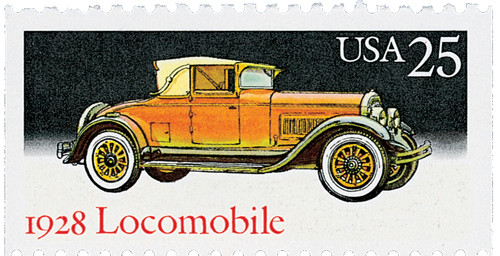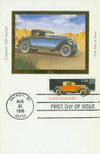
# 2381 - 1988 25c Classic Cars: 1928 Locomobile
U.S. #2381
1988 25¢ 1928 Locomobile
Classic Cars
- From booklet pane of 5 Classic Cars produced between 1925 and 1942
- Issued at STAMPSHOW ’88 in Detroit, Michigan
Stamp Category: Commemorative
Set: Classic Cars
Value: 25¢, first-class rate
First Day of Issue: August 25, 1988
First Day City: Detroit, Michigan
Quantity Issued: 127,047,000
Printed by: Bureau of Engraving and Printing
Printing Method: Lithographed and engraved
Format: 4 panes of 5 per booklet
Perforations: 10 horizontal on 1 or 2 sides
Why the stamp was issued: The years 1925 to 1942 are considered by many to be the age of the classic car. The 1988 booklet pane of five different designs features the "classiest of the classics" from that era.
About the stamp design: Ken Dallison was hired to design these stamps. He had experience both in designing stamps and creating automotive art. Dallison received a list of the makes of cars and was permitted to select the model years he deemed best for artistic purposes. He created pen-and-ink-wash designs of each car based on archival and personal photos.
Special design details: All the cars in the pane face to the right, but progressively point from slightly to the side to straight ahead, to give a fanning effect to the booklet from top to bottom. Also, the tagging on each stamp was customed to fit the white space around each car.
First Day City: The First Day ceremony for the Classic Cars stamp booklet was held at Cobo Hall before STAMPSHOW ’88 in Detroit, Michigan, the Motor City. The show was the 102nd annual convention of the American Philatelic Society. Actual examples of each car were on display next to posters of the stamps.
About the Classic Cars Stamps: Plans for a group of stamps honoring old American automobiles dates back to 1979. At the time it was proposed to be a se-tenant of four and two artists were commissioned to sketch their own blocks. Over time, some of the vehicles pictured on these stamps were used in the Transportation Series or other sets. Then the Citizens’ Stamp Advisory Committee decided to make this issue a booklet pane of five and tasked the Topic Subcommittee with producing a list of cars made by companies that weren’t still in operation. They came back with a list of 12 which was narrowed down to five.
History the stamp represents: The Locomobile, the oldest car in the set was built in Bridgeport, Connecticut, in 1928. The company began by making steam cars in 1899 and combined locomotive and automobile to get its name. They soon switched to gas-powered engines and luxury cars. Durant Motors bought out the company in 1922, which ran it until its production ended in 1929. The Locomobiles sold for almost $2,000 – equal to about $80,000 in today’s wages.
U.S. #2381
1988 25¢ 1928 Locomobile
Classic Cars
- From booklet pane of 5 Classic Cars produced between 1925 and 1942
- Issued at STAMPSHOW ’88 in Detroit, Michigan
Stamp Category: Commemorative
Set: Classic Cars
Value: 25¢, first-class rate
First Day of Issue: August 25, 1988
First Day City: Detroit, Michigan
Quantity Issued: 127,047,000
Printed by: Bureau of Engraving and Printing
Printing Method: Lithographed and engraved
Format: 4 panes of 5 per booklet
Perforations: 10 horizontal on 1 or 2 sides
Why the stamp was issued: The years 1925 to 1942 are considered by many to be the age of the classic car. The 1988 booklet pane of five different designs features the "classiest of the classics" from that era.
About the stamp design: Ken Dallison was hired to design these stamps. He had experience both in designing stamps and creating automotive art. Dallison received a list of the makes of cars and was permitted to select the model years he deemed best for artistic purposes. He created pen-and-ink-wash designs of each car based on archival and personal photos.
Special design details: All the cars in the pane face to the right, but progressively point from slightly to the side to straight ahead, to give a fanning effect to the booklet from top to bottom. Also, the tagging on each stamp was customed to fit the white space around each car.
First Day City: The First Day ceremony for the Classic Cars stamp booklet was held at Cobo Hall before STAMPSHOW ’88 in Detroit, Michigan, the Motor City. The show was the 102nd annual convention of the American Philatelic Society. Actual examples of each car were on display next to posters of the stamps.
About the Classic Cars Stamps: Plans for a group of stamps honoring old American automobiles dates back to 1979. At the time it was proposed to be a se-tenant of four and two artists were commissioned to sketch their own blocks. Over time, some of the vehicles pictured on these stamps were used in the Transportation Series or other sets. Then the Citizens’ Stamp Advisory Committee decided to make this issue a booklet pane of five and tasked the Topic Subcommittee with producing a list of cars made by companies that weren’t still in operation. They came back with a list of 12 which was narrowed down to five.
History the stamp represents: The Locomobile, the oldest car in the set was built in Bridgeport, Connecticut, in 1928. The company began by making steam cars in 1899 and combined locomotive and automobile to get its name. They soon switched to gas-powered engines and luxury cars. Durant Motors bought out the company in 1922, which ran it until its production ended in 1929. The Locomobiles sold for almost $2,000 – equal to about $80,000 in today’s wages.














